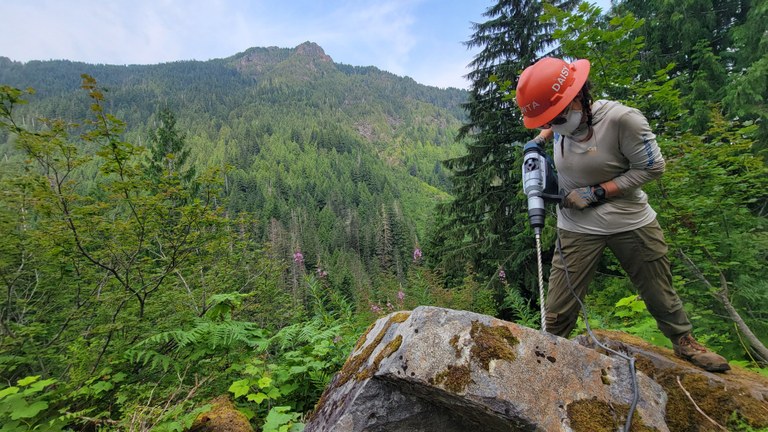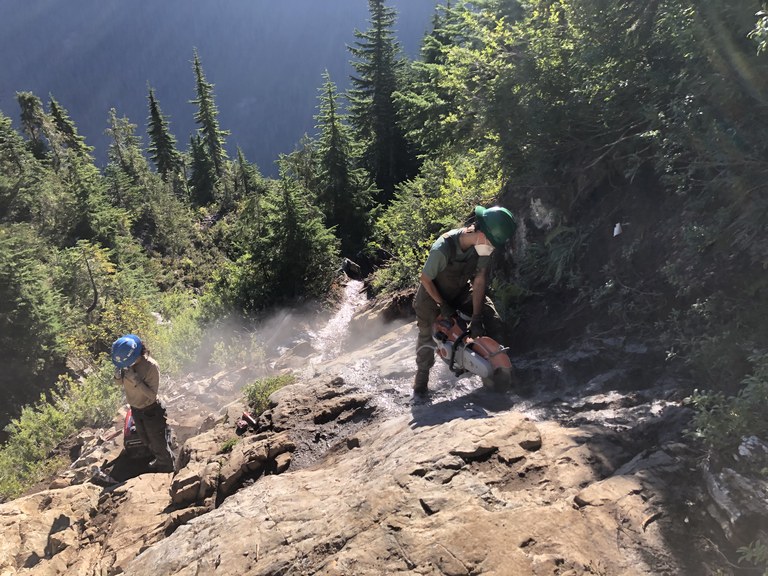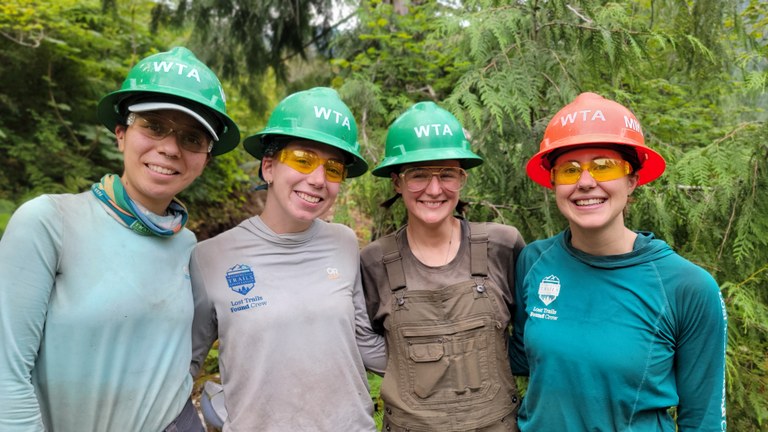How professional WTA trail crews kept trails on the map in 2024
Our paid trail crews specialize in working on hard-to-reach backcountry trails. Here’s what they accomplished in 2024. By Joseph Gonzalez
Washington is home to three national parks, eight national forests, 31 wilderness areas and millions of acres of state-owned land. That’s a lot of trails! Seriously, our Hiking Guide and trip reports offer insight on 4,000+ trails and is growing daily.
Trails don’t manage themselves, and backcountry trails in particular are tough to maintain. Their rugged locations make them hard to access, and between climate change and a lack of regular maintenance funding, they’re particularly vulnerable to being lost and forgotten. That’s where our Lost Trails Found (LTF) crews come in: teams of professional trail stewards who specialize in breathing life back into backcountry trails that are especially challenging to maintain.

Some large projects — like a hitch to Boulder Lake in August — can accommodate two crews instead of one. Photo by Joseph Gonzalez
Now in its fourth season, this year’s professional program is bigger and badder than ever. In 2024, we added a third crew, and promoted past crew members to crew leaders and assistant crew leaders. Behind the scenes, Lost Trails Found leadership continued to strengthen with the leadership of Lost Trails Found Coordinator Zack Sklar and Professional Services Manager Joe Hall. This allows us to continue to strengthen partnerships with land manager partners, old and new alike.
“Our land manager partners don’t have a ton of budget flexibility. Often when they get money, they can buy stuff, but it’s very hard to buy people power. That’s an area where we have a lot more flexibility. Our donations can go directly to somebody swinging a Pulaski,” explains Joe.
Serving Washington’s national forests
The paid trail crew program was created in 2021 in part with funding from the Great American Outdoors Act as a way of protecting and improving access to national public lands. True to its roots, our professional program spent lots of time this summer refurbishing trails in national forests.
The Okanogan-Wenatchee National Forest’s own Naches ranger district was devastated by the Schneider Springs fire in 2021. Our crews have spent the last two seasons working there to restore lost trails in the fire recovery zone with a goal of unlocking up to 50 miles of trails. Burn areas can be hazardous to work in, but between the crew’s technical experience and their full-time schedules dedicated to revisiting projects over summer, professional trail maintainers can tackle ambitious, technical projects.

Crew leader Zenwa Shimabukuro saws through a downed log — a common sight in burn areas. Photo by Joe Hall
Maintenance on trails lost to fire damage like these is challenging work. Sun exposure and eroded soil makes for tough working conditions, and each summer the crew must re-clear sections of trail after winter storms have knocked down more trees. This summer’s efforts have resulted in breakthroughs to backcountry areas seldom visited since before the fire in 2021, accumulating in 17.5 miles and 569 logs and counting. Several more hitches are scheduled to hit the Naches this fall.
Natural resource land gets a facelift
The LTF crews’ early years were focused on US Forest Service land. But they did such good work that the Washington Department of Natural Resources (DNR) requested the partnership of our professional crews back in 2023, which resulted in two hitches at Gothic Basin. We committed to working with DNR again this year, focusing maintenance on trails beloved by the public, but deeply in need of care. The result: nine backcountry hitches on lands managed by DNR in 2024.
Among those hitches, our crews split their time on state-managed trails between Gothic Basin (four hitches) and Boulder Lake (five hitches). Although some USFS projects lend themselves to logout work, it was the crew’s tread reconstruction and heavy rock work at Melakwa Lake in 2022 that initially caught the attention of DNR.
This breadth of skills makes our paid crews adaptable to a variety of technical projects.
Joe Hall explains: “Our professional program has grown to a point where we are beginning to be viewed as the stewards, technical experts and problem solvers for tough trail projects. We’re even getting asked to train land manager crews.”

Assistant crew leader Daisy Rios wields a rock drill at Gothic Basin. This project was made possible with tools and helicopter-drop assistance from Washington Department of Resources. Photo by Joseph Gonzalez
With DNR’s trust and support, our pro crews have been exposed to a variety of technical projects. DNR is even able to fly tools into worksites via helicopter, from rock bars to power drills. These added tools and resources allow our crews to address a variety of ambitious tasks, from building check steps, to drilling, shaping and chiseling rocks themselves.
WTA staffer Anna Roth caught the crew working in a particularly exposed area on a hike in early September.
“I was so impressed at how much progress they had made in just the hour or so between my hike up and back down. On the way up there were barely any toeholds in this slab of granite that could have required three points of contact, but on the way down there were these nice steps. Everyone hiking nearby was grateful for their hard work, especially since it was so hot and muggy that day!”

Steps make the route up to Gothic Basin a little safer. Photo by Zack Sklar
2024 stats
How does a season worth of professional trail work affect the everyday Washington hiker’s experience? Here are a few stats from what our crews have done so far this year:
- 15,834+ plus trail maintenance hours accrued across the state
- 81+ miles of lost trails maintained
- 2,522+ blowdowns have been logged out
- 26 trails worked on
- 36 work parties completed
Building the trail careers of tomorrow
The professional model isn’t just about building trails — it’s also all about building careers. Creating opportunities for full-time employment and the development of leadership skills helps the people working on this crew get a foot in the door and progress professionally.
The curriculum covers a crosscut saw certification course at the start and end of every season, plus numerous other trainings to develop well-rounded skill sets. The internal development of crews was on display in 2024: several former crew members moved into assistant crew leader positions, and several assistant crew leaders became crew leaders.
“It’s awesome to get the education that we’re getting along the way and to learn more technical skills and to learn from each other,” explains assistant crew leader Mikayla Clarke (in the orange hard hat below). “Earlier this summer, we built a puncheon bridge at Boulder River. That was all brand new to me.”

Everyone on the team brings an experienced skill set — and a great attitude. Photo by Joseph Gonzalez
This sort of professional development is made possible by a rock-solid curriculum curated and taught by seasoned trail maintenance veterans who have shared their knowledge year-over-year. Each crew is composed of members with varied trail maintenance backgrounds, from structure building to logout.
And while each individual brings expertise in one or more areas of work, they’re also encouraged to grow into other areas that fit their interests and the crews’ collective needs. The results are well-rounded teams that fit a niche in the industry between land manager crews and volunteers.
“This is a really skilled industry. Our crew members walk away from each season being masters of these very unique skills that are only obtained by coming out here and doing the work,” shares Joe Hall. “And beyond actual trail work, WTA has a lot of development opportunities for folks who might not want to dig in the dirt for their entire career.”
Several WTA employees, like Zack Sklar and Angelic Friday, cut their teeth in WTA's Lost Trails Found program and have since moved into office-based coordinator roles.

Soon the paid crews will end their season and rest. The 2025 season will pick up again in the spring, with hiring ongoing this fall. Photo by Joe Hall
Trails, just like the professional trail maintenance community, are ever-changing ecosystems. They both need care, infrastructure and resources to persevere into an uncharted future where backcountry trails, and the experts who maintain them, will continue to face uncertainty in the wake of natural disasters and limited federal funding.
But on the backs of community, knowledge-sharing and professional development, many of Washington's lost trails will continue to be brought to the light.
WTA’s Lost Trails Found crews end their season in late October — when the leaves have changed and the days are shorter. They’ll finish their last hitches in the Eastern Cascades before putting a stamp on 2024. Then we’ll look forward to the Lost Trails Found 2025 season, which begins hiring in early October.


Comments